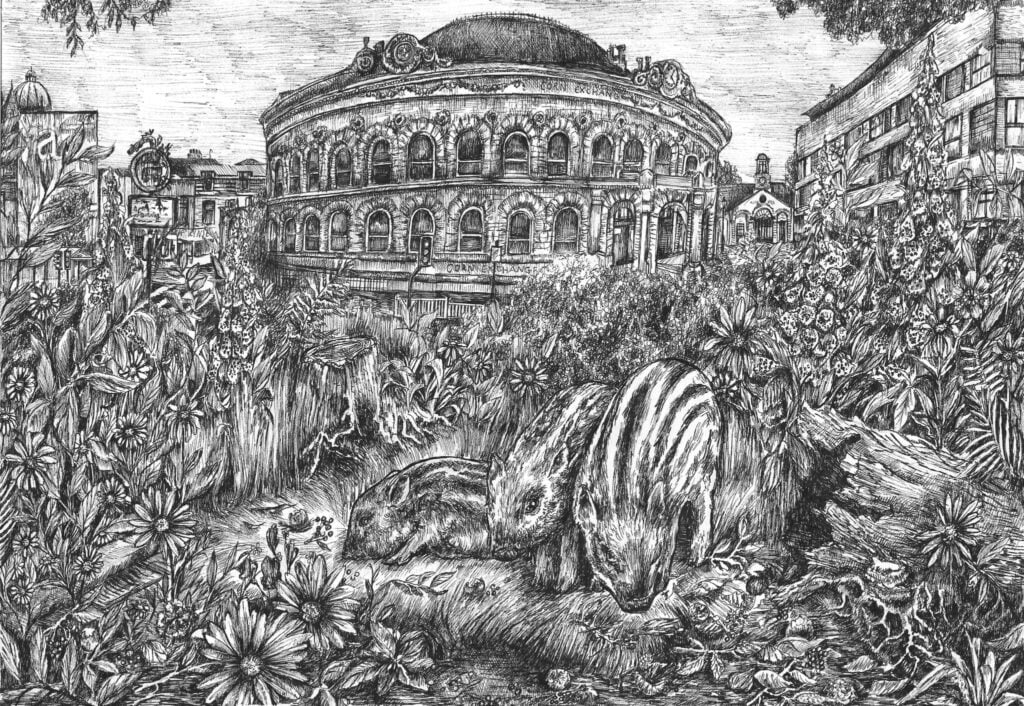
Katie Bennett-Rice, ‘Boar Lane’
The Leeds Summer Group Show is an annual exhibition started by Courtney Spencer started in 2015. This year she partnered with Leeds Inspired, CuratorSpace and The State Of The Arts to present the 2020 exhibition online in response to the unusual set of circumstances. From almost 400 submissions, the selection panel chose 38 artists to exhibit and awarded six shortlisted artists/collectives with a share of the £600 cash prize and, luckily for our readers, an interview on The State Of The Arts! The artists are: Sarah Roberts, Paris Crossley, Nisa Khan, Katie Bennett-Rice, Alice Chandler and ACCA.
Below is the fourth in our series of interviews: this time we chatted with Katie Bennett-Rice, an artist with a patient love of nature, even in the most unexpected places.
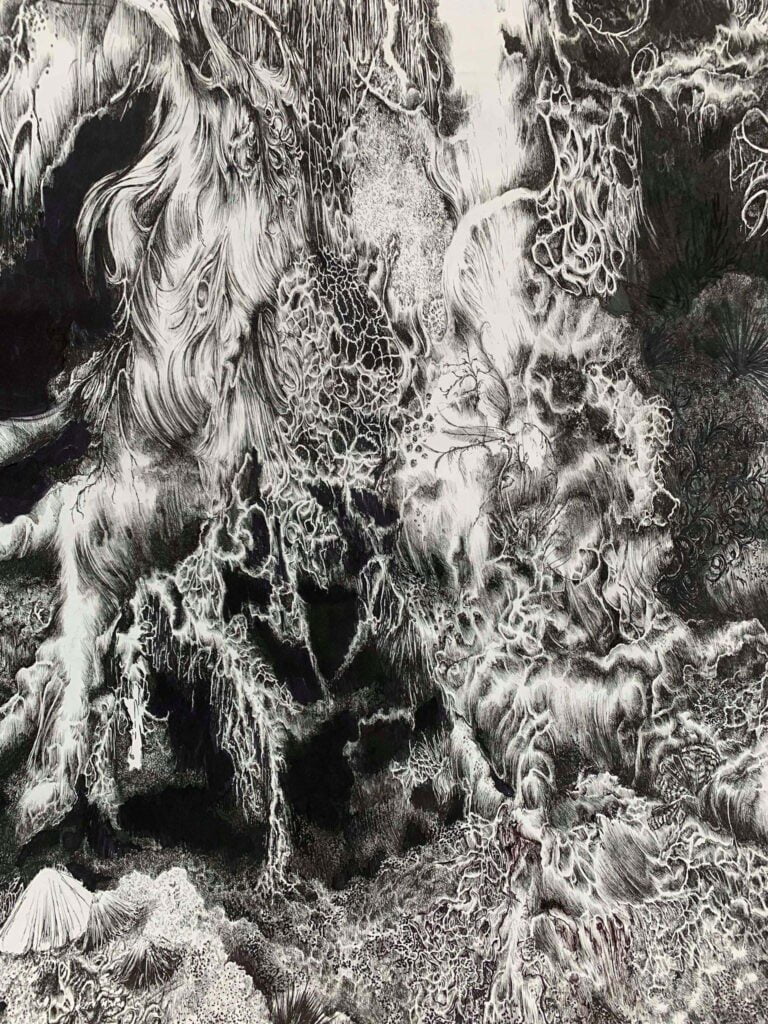
Katie Bennett-Rice, ‘Holdfast’
What are the main themes running through your work?
The natural world is probably the most overt theme within my work, but I think the distinction between looking and seeing is also a really important theme. Focusing on the unseen and the hidden, my work tries to expose this for the viewer to really take in a scene. Approaching a place with a childlike fascination is important, paying equal attention to all the parts of an environment and seeing all of their intrinsic values. I like to think my work has a nostalgic quality to it of fold-out illustrations from children’s books, filled with characters and items to find, sparking a curiosity in people.
Place and setting therefore, are definitely important, especially ‘imaginings and reimaginings’ of familiar scenes or objects – for example the fantastical and almost fictional Holdfast kelp forest I exhibited at the Leeds Summer Group Show, an underwater world formed from a piece of mundane seaweed washed ashore.
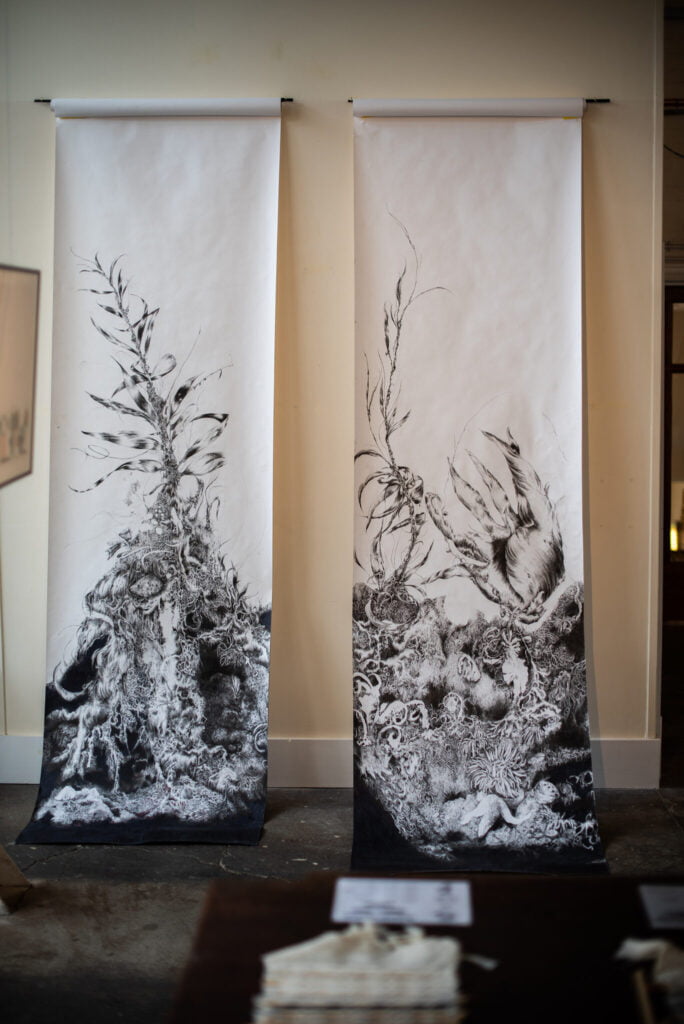
Katie Bennett-Rice
What were the first artworks/ artists/ experiences that made you want to create art yourself?
It’s definitely a cliché but I’ve wanted to create and make since I was very little. The first drawing I can remember being all over my mum and dad’s chairs with my favourite purple felt tip. Growing up in Birmingham, nature very much felt like it was a place you went out and found, little pockets of wild hemmed in by carparks and metal fences, where I would invent swamps and jungles with crocodiles instead of fallen trees and rumbles of tropical thunder instead of the motorway hum. There’s a small stream a short walk from my house where me and my sister and dad would make damns, mud pots and potions. I think that curiosity and exploration of the outdoors within a city formed a lot of my interest as an adult about actively seeking out wildlife in all settings of life, especially urban ones and encouraging everyone to get out into green spaces and absorb the magic of them, no matter how small.
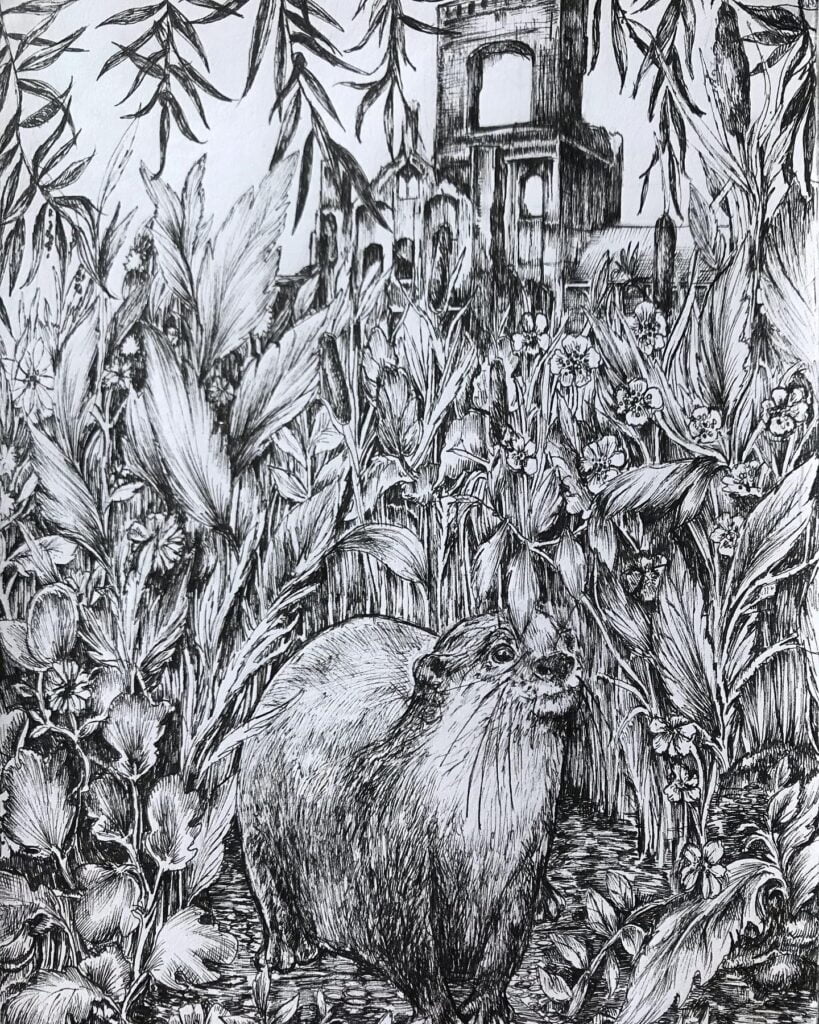
Katie Bennett-Rice, ‘Beyond the Bridge’
Tell me about the significance of time in your work, your pieces must take a lot of time and patience to create.
The slow drawing process is a bit of a labour of love. The constant building of layers and thinking of where to leave the negative space for tangling branches is surprisingly forgiving. I make the plants and animals around where the marks have overlapped and naturally formed an organic line to follow, much like the growth of nature itself. This leads me through the work rather than me deciding where to go. Mimicking this slow growth seen outdoors is really contemplative and calming, and I think that people can feel the time in the work as a sort of ‘age’ of the landscape being depicted, which in turn adds to that feeling of natural awe and incomprehensibility, what we think we know and see as opposed to what’s really hidden between branches and under leaf litter.
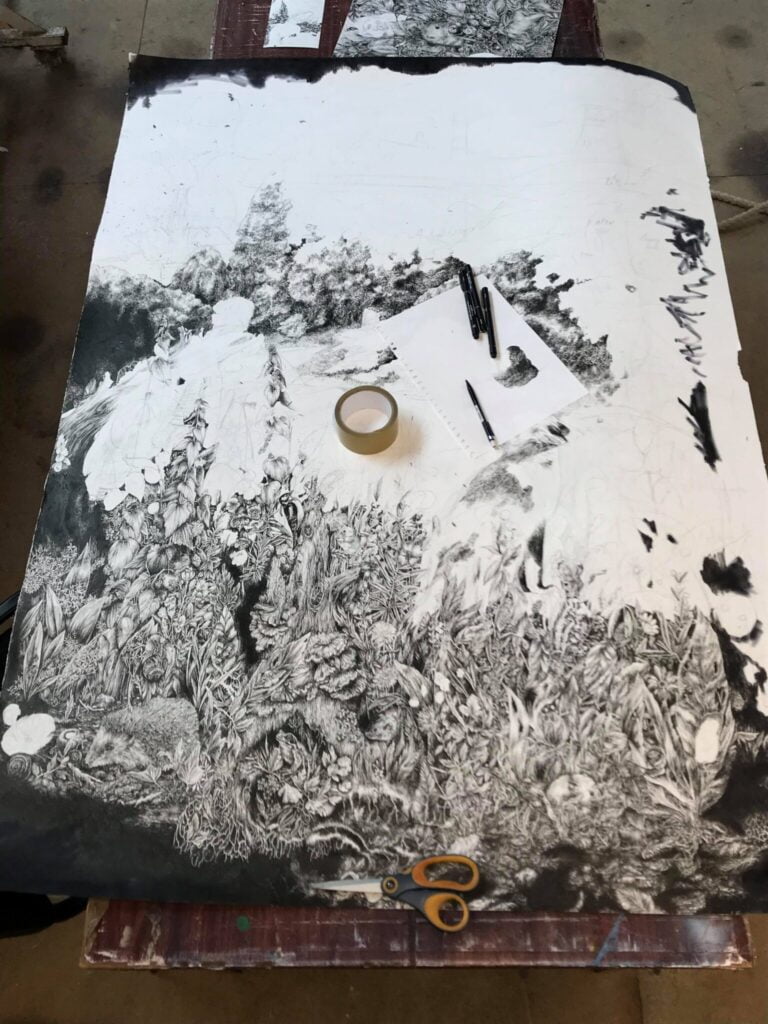
Katie Bennet-Rice, ‘Holdfast’, progress
How has art and making accompanied you through the pandemic so far? Has it helped in any way or has your relationship to it changed?
In honesty it’s been a bit of a lifesaver, I was furloughed at the end of March and luckily had drawing and gardening to help create some calm and build a new routine in that really uncertain period. Being confined to a small concrete front garden on a main road and not having access to parks at the beginning of lockdown was really challenging and definitely made me appreciate what is literally on my doorstep and made me question where I’d considered the natural world to be. I started my largest piece yet during lockdown based specifically around the locations close to my home in Burley. I’ve definitely realised the benefits creating brings to me emotionally and mentally, while I think previously, I had taken them for granted.
I would also say art helped me to feel connected and stay social with others, with the move of most exhibitions online and the ‘all in the same boat’ feeling really showing the strength of the creative community in Leeds. I’ve ‘met’ some wonderful people I probably wouldn’t have spoken to if not for that sense of breaking down social barriers that occurred with the increased reliance on social media. It is a really bizarre situation of having met other artists and formed friendships without having ever met in person and was a really surprising but welcome outcome of the restrictions.
What’s the purpose of art?
What a question! I think art has always been about communication to some degree, whether of an idea, emotion, protest, or just the incommunicable and inexpressible. Its purpose or effect is in constant flux, determined by whom or where it’s being received. I do also think there doesn’t need to be a purpose, and that purpose enough for art can simply be ‘just because’. Personally, for me I think at this present time it’s really a source of output and escape in its creation but I wouldn’t say that it has been created for a purpose, that cathartic release is a welcome side effect If you will!
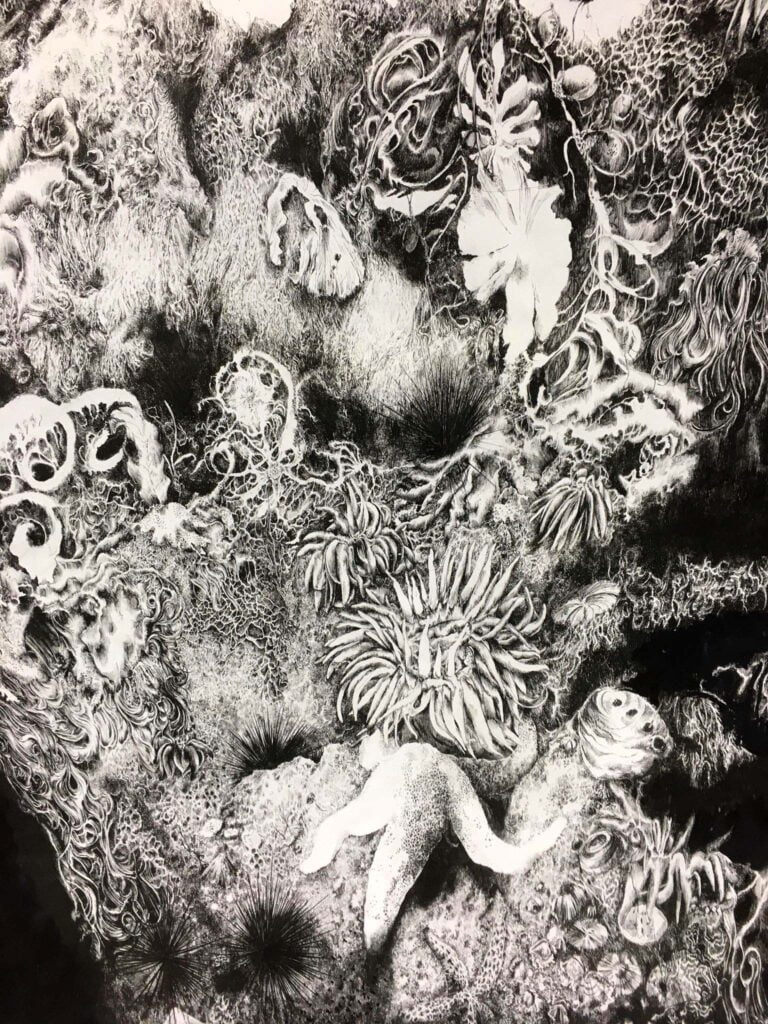
What is your main source of inspiration at the moment?
The seasonal transition of summer/ autumn/ winter is really captivating me at the moment, I feel like it’s amplified this year as so much of our social interaction has been happening outdoors. The change of weather and die back and new growths of plants is really transforming places and I’m really eager to record it in drawing at the moment. I have been reading lots about plants and mushrooms lately and learning to identify species, which is great to expand the details I want to include! The woods, in particular those around Weetwood and Far Headingley, are really coming alive with such a diverse variety of fungi at this time of year, with that whole idea of cyclical nature, regeneration and regrowth offering some reflective and optimistic inspiration.
You can see Katie’s website here or her Instagram at @katiebennettrice
Filed under: Art & Photography
Tagged with: animals, art, artist, covid19, drawing, exhibtition, Katie Bennett-Rice, leeds summer group show, lockdown, Nature, pandemic
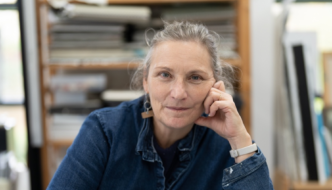
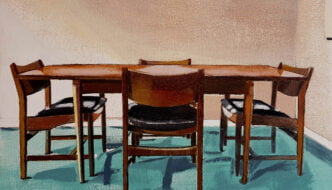
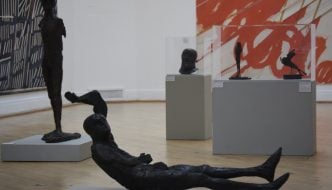
Comments